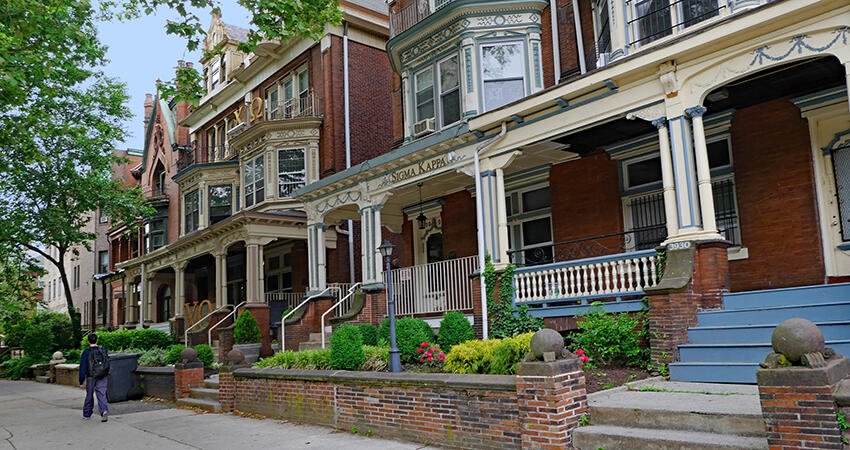
(Spiroview Inc/Shutterstock)
How Do the Presidential Candidates’ Housing Plans Measure Up?
Housing policy is front and center this election cycle. As we gear up for November, both presidential candidates have announced housing plans to address some of the top challenges facing voters: lack of accessible affordable housing in the United States.
These plans come as many voters, especially young ones—who make up an increasing share of the electorate—have expressed their frustrations about the housing market. We’ve already explored the top housing issues motivating young voters today and what innovative housing investments could look like for the next generation.
Now, a couple of weeks out from the election, we analyze what—and who—is missing from both candidates’ housing plans and discuss how they could better meet the housing needs of all American families.
To better understand the question, and to highlight the views of young people, who are critical in this election and those moving forward, we interviewed young Urban Institute experts who study housing policy with different lenses. They shed light on how rising housing costs have affected American families and how well-designed, well-implemented federal housing policy agendas can promote financial well-being, upward mobility, and the physical and emotional health of millions of households across the country.
What challenges are the candidates’ plans trying to solve?
With limited housing and rising interest rates, accessing homeownership has become increasingly challenging. Meanwhile, rising rents relative to incomes have resulted in a historically high share of rent-burdened households. Our recent survey research finds the majority of renters across all income groups are saving less and cutting back more than the previous year because of the rent increase.
The decision to buy a home, however, goes beyond just household finance. Many people aspire to live in areas with plentiful job opportunities and proximity to valued amenities, including schools, restaurants, grocery stores, parks, and hospitals. Lizzy Ferrara, an Urban Institute policy analyst who explores housing as a key structural and social determinant of health, also emphasized the importance of having a supportive community of people near one’s home. Research shows a home’s location affects one’s health, social relationships, and many other aspects of a person’s life. Ferrara said she would like to see policymakers look at housing from a more holistic viewpoint, focusing not just on how many units need to be built, but also where.
In recent decades, housing has become especially unaffordable in larger cities with more jobs and amenities. Housing development is constrained by zoning and building codes and transportation policies that purposefully distance homes from jobs and amenities (PDF). As a result, many early-career young people or those who earn lower incomes must make difficult housing choices. Research analyst Katie Visalli pointed out that many young adults in their early careers often only find affordable housing that’s farther from jobs, requires a longer commute, and is located far from amenities.
Housing affordability can have ripple effects on many Americans’ daily lives. Unaffordable housing has led American families to save less for rainy days, mull over what spending to cut, and spend more time on transportation to jobs. Research shows longer commutes can reduce time spent with social networks and lead to negative health outcomes.
“I’ve come to learn how housing intersects with every social issue and is one of our biggest challenges. This is an issue that affects everyone and needs to be a priority for folks in the policy space because our economy, work, and daily lives relate to where we live and how we’re living.”
—Nyla Holland, Policy Analyst, Urban Institute
Harris’s versus Trump’s solutions to limited housing supply
Acknowledging the growing struggles and frustrations of American families from increased housing unaffordability, both the Harris and Trump campaigns have announced how they will tackle these issues from both the demand and the supply side.
The current lack of affordable housing can be explained with a basic economics principle: a mismatch between housing supply and demand. Following the Great Recession, US housing production decreased significantly while the population grew, increasing home prices and rental costs—a trend that’s continued to this day.
Both presidential candidates say they will solve the housing affordability crisis problem by either expanding the supply or curtailing the demand. Because significant undersupply is the key reason for the current housing unaffordability crisis, plans to promote more housing supply are steps in the right direction.
The Harris campaign has proposed an ambitious plan (PDF) to grow the housing supply by an additional 3 million new units. To do so, the plan includes a new tax incentive for starter homes, expansion of tax incentives to build affordable rental housing, allocation of $40 billion in innovation funds to support innovative local solutions for housing development, and reduced red tape and bureaucracy to facilitate the speed of housing development.
To build 3 million units of new housing supply in four years, the country would need to produce 750,000 more units than it otherwise would every year. This is about a 50 percent increase from what we produce now, but it’s still a feasible number based on the historical number of housing starts. In the early 1970s and mid-2000s, housing starts were about 50 percent higher than in the most recent 5 years, and building technology has improved since then. However, because the costs of land, labor, and raw materials have all risen, and the cost of housing construction is heavily based on state and local land-use and zoning regulations, incentivizing state and local government to align with the federal goal would be critical for the plan to be realized.
The Trump campaign hasn’t released a detailed housing plan, but he said he would work on deregulation and promised to open portions of federal land for large-scale housing construction. A similar proposal was included in President Joe Biden’s latest housing plan. As for freeing up federal land, the share of federally owned lands varies significantly across regions (PDF), and a large portion of federal land isn’t suited for housing development, nor is it located in desirable areas. A huge investment would likely be needed in infrastructure before housing is built. More analysis is required for a detailed examination of where these lands are and whether they have sufficient infrastructure to make it economically viable to build housing in these areas.
Additionally, in 2023, Trump shared a plan to create up to 10 “Freedom Cities” on the grounds of federal land. Not much detail has been provided, and it’s uncertain how these cities will meet the needs of American families.
Harris’s versus Trump’s solutions to support or curtail housing demand
The lack of housing supply is the core reason for housing unaffordability in the current market, yet the two candidates have also announced demand-side solutions that could lower the cost of accessing housing. This is where Harris and Trump’s approaches differ most.
Harris has proposed (PDF) providing first-time homebuyers, who are more likely to be younger adults, with $25,000 down payment support. The plan says it will provide more generous support for first-generation homebuyers but doesn’t specify the amount. Being unable to cover a down payment is the most frequent barrier to homeownership. The increased home prices and high interest rates have prompted households with the means to put more down upfront in an effort to enhance their chance of getting a mortgage and lower their monthly cost, making it more difficult for young households, especially those with fewer resources, to access homeownership. However, critics have pointed out that providing down payment assistance would have inflationary effects on already elevated home prices without expanding access.
The success of this plan would depend on how quickly new housing supplies can be added to the market. Our work shows first-generation down payment programs could have less inflationary impact if the number of potential recipients is limited. Timing down payment assistance to follow housing supply increases and starting with a more targeted program would enhance its effectiveness.
In contrast, Trump proposes to curtail demand by deporting immigrants and making it more difficult for them to access homeownership. Even if the plan is successful, it’s unclear how effective it would be because undocumented immigrants already face significant challenges accessing both rental and owner-occupied housing:
- Landlords can require prospective tenants to have a Social Security Number (SSN), and those without an SSN are often required to put down significant amounts for deposits.
- Buying a home without an SSN, even among undocumented immigrants who pay taxes, is already extremely difficult, so very few mortgage loans are made to undocumented immigrants.
- Faced with challenges in access to housing, more than two-thirds of illegal immigrants are estimated to live with legal immigrants, which limits the impact of deporting them on the size of housing demand.
Immigrants also account for a large share of workers in the construction sector, so the reduction of the immigrant population would likely increase the labor cost of construction workers and could further stifle the housing supply.
So far, the Trump campaign hasn’t announced plans to address the growing inequalities in access to homeownership that have contributed to the growing wealth gap in the United States. Research shows that wealth inequality between homeowners and renters has reached a historic high, and wealth inequality among young adults has widened compared with previous generations. Without intentional policies to support young renters who do have the benefit of inheriting generational wealth, the US is likely headed toward a greater wealth inequality.
The current presidential housing plans don’t address the needs of all Americans
Housing unaffordability is getting a spotlight in the presidential candidates’ policy proposals, which shows both candidates are aware of how important the issue is to voters. But these plans need to be properly analyzed to quantify their potential and feasibility. More detail is needed on how they’ll be implemented. And evidence suggests the most effective plans will focus on addressing the housing challenges that affect households the most.
Though housing costs have increased for most Americans, the intensity and the aspects of the struggles differ across households—which means tailored solutions may be needed. Renters who’ve been unable to successfully access homeownership when the rates were historically low are experiencing greater financial challenges, especially those with lower incomes and wealth. These households, however, are largely left out of the presidential housing plans.
Brendan Chen, an Urban Institute research analyst who focuses on homelessness, pointed to the growing number of people in the US who are unhoused and emphasized the need to change the perception of the homeless population, who mostly have transitory or unstable housing status, and to create policies and programs that ensure stable housing. Chen also noted that there is a big difference between ending homelessness and increasing the supply of affordable housing, but there is some “muddying of the waters” between the two in today’s policy debates. Sam Hoppe, a former research assistant, also underscored that though homelessness is increasing, it’s not taken seriously enough, and many still blame homelessness on mental health challenges and lack of employment, even though research shows homelessness is closely related to housing availability and affordability.
To address the interconnectedness of housing problems across the country, the Urban Institute recently released a comprehensive national housing strategy road map for affordable and stable housing for all. It provides not only solutions to catalyze new construction but also ways to unlock and preserve existing housing inventory for renters and homeowners. The roadmap offers tailored policy solutions to support the housing needs of various populations—from households struggling to purchase their first homes to those facing challenges to have a sustainable roof over their heads. The road map can inform policymakers to improve and implement housing plans and policies beyond the election to solve a wide spectrum of problems stemming from unaffordable housing.
Ultimately, it will be up to the voters to decide who they think is the best equipped to address the challenges they face and then hold that leader accountable come January to ensure housing remains a central focus on policy and planning in coming years.


